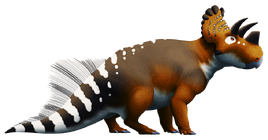
Wendiceratops (wen·di·cer·a·tops) is a genus of herbivorous centrosaurine ceratopsian dinosaur from the Late Cretaceous of Canada.[1]
Discovery[]
Reconstruction of the parietal bones of Wendiceratops and other centrosaurines
In 2010, Canadian fossil hunter Wendy Sloboba found a centrosaurine bonebed in the Pinhorn Provincial Grazing Reserve south of the Milk River, County of Forty Mile No. 8, Alberta. In 2011, a team of the Royal Tyrrell Museum explored the site and began excavating fossils. Next year, a deep overburden was removed. In 2013 and 2014, numerous fossils were discovered.[1]
In 2015, paleontologists David Evans and Michael Ryan named and described the type species Wendiceratops pinhornensis. The generic name combines a reference to Wendy Sloboda with a Latinised Greek ~ceratops, "horn face". The specific name refers to the provenance from the Pinhorn Reserve.[1] Wendiceratops was the second ceratopsian discovered and named in 2015.[2] The discovery of this new horned dinosaur species - starting from the ground in Alberta, through scientific study and restoration, all the way to its eventual reconstruction and public display in The Royal Ontario Museum (ROM) - was captured in the HISTORY series and companion website Dino Hunt Canada.[3]
The holotype, TMP 2011.051.0009, was found in a layer of the Oldman Formation, dating from the Campanian. The layer of mudstone, forty centimetres thick and probably deposited in a single event, has an upper possible age of 79 million years and a lower age of 78.7 million years. The holotype consists of a right parietal bone. Under the assumption that the bonebed contained only a single centrosaurine species, all additional centrosaurine material was referred to Wendiceratops pinhornensis, for a total of 184 specimens representing several individuals, including juveniles. The bones compromise elements from the skull, lower jaws, vertebral column, shoulder girdle, pelvis and limbs. They are largely disarticulated. In addition to the Wendiceratops bones, remains were found of tyrannosaurid theropods, crocodiles, gars and plants.[1]
Description[]

Restoration
Wendiceratops was one ton heavy and had a length of about six meters (20 feet).[2]
The describing authors indicated two unique traits, autapomorphies. On the rear rim of the skull frill, the second and third epiparietals, the skin ossifications attached to the rim, have a wide base, are vertically thick and curve obliquely upwards to the front, overhanging the rear and outer side branches of the parietal bone. The ischium has an expanded rectangular lower end.[1]
Wendiceratops is further distinguished by the lack of a vertical spike on the rear frill and an erect nose horn. The Chinese Sinoceratops has similar epiparietals, but in addition a central midline epiparietal and bumps below the epiparietals, lacking in Wendiceratops.[1]
Evolutionary relationships[]
Wendiceratops was placed in the Centrosaurinae, as a sister species to Sinoceratops. Their clade formed a "comb" or polytomy with Albertaceratops, another centrosaurine from the same formation, and the clade of the more derived centrosaurines.[1]
The nose horn of Wendiceratops, erect but probably of moderate size, was by the describing authors seen as a transition between the low horns of earlier forms like Diabloceratops, Nasutoceratops and Albertaceratops and the much taller horns of derived centrosaurines such as Coronosaurus, Centrosaurus and Styracosaurus.[1]
Paleobiology[]
Being found in the Oldman Formation, Wendiceratops shared its habitat with other dinosaurs such as Daspletosaurus, Paronychodon, Troodon, Albertaceratops, and Parasaurolophus. The authors pointed out that after the discovery of Wendiceratops, no less than five ceratopids are known from the Oldman or coeval North-American formations, in addition to Albertaceratops also Judiceratops, Medusaceratops and Avaceratops. They assumed this was made possible by ecological specialisations and also indicated a high faunal turnover, a quick succession of related species.[1]